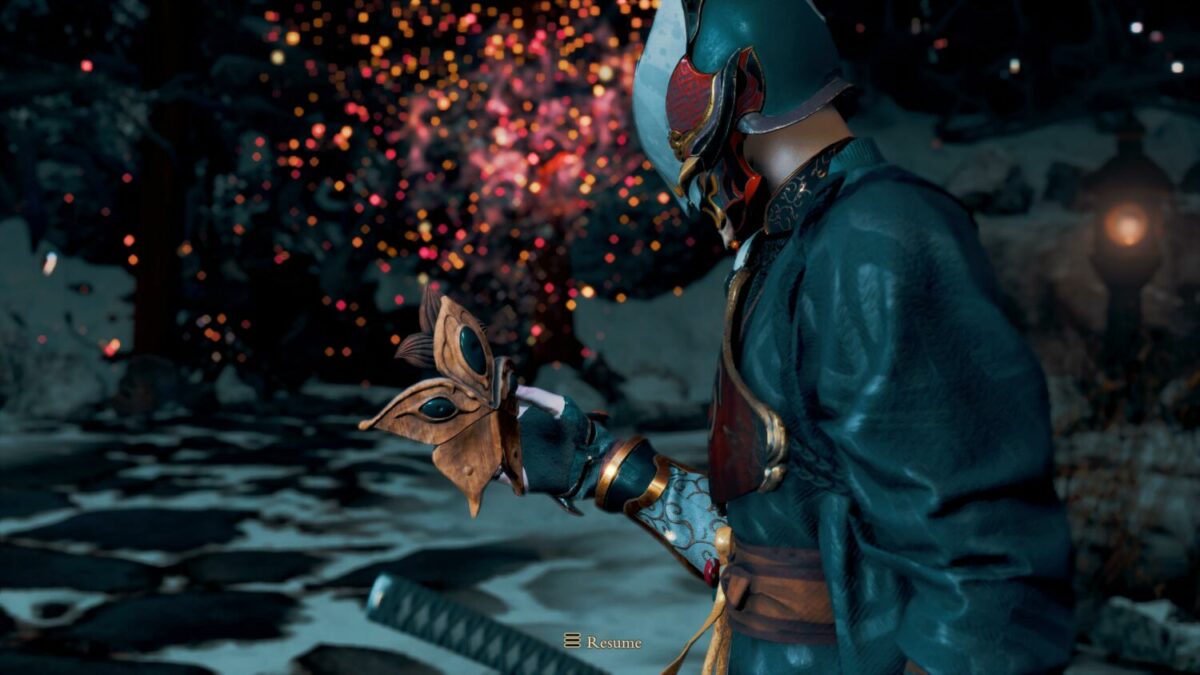Fortune favours the brave, or so the saying goes. Back in 2006, Capcom’s Okami painted a shining picture of video games as an art form, eschewing realistic visuals for a breathtaking canvas adorned with a cel-shaded and watercolour flair. It suffered from poor sales, bolstering the argument for adopting a tried-and-tested formula, but earned a proud, enduring legacy that few can boast – one of the all-time industry bests.

The company’s upcoming romp, Kunitsu-Gami: Path of the Goddess, shares the same spirit of innovation. Like its culturally rich peer, featured in a special in-game collaboration that runs until 17 July, it challenges the idea of conventional genres, aligning with its billing as a “unique Japanese-inspired, single-player Kagura action strategy game”. Tower defense elements make up a core part of gameplay, as is the ability to control an active character in the field and execute combo chains in rhythmic, elegant strokes.
There’s plenty of pizzazz to bask in, too. The hybrid adventure pulls from Japanese mythology and folklore, featuring striking colours that breathe more life into the world. Between the distinctive visual identity and unique blend of gameplay, Kunitsu-Gami: Path of the Goddess comes across as a refreshing entry that’s bold enough to be off the beaten path and thrives at being so. It holds no reservations in dancing to their tune, and there’s merit in that – strengths, flaws, and all.
Revolving around a tight gameplay loop, the kaleidoscopic charmer follows Soh, a swordsman tasked to protect a divine maiden named Yoshiro as she cleanses blighted villages and restores peace to Mt. Kafuku. The player, stepping into the role of the mask-wearing protector, has to slice enemies into ribbons, place troops within a fixed area, and carve out a road for her to purify torii gates, inflicted with “defilement”, and head towards the next objective.

A deceptively simple premise, it’s driven by a fair bit of nuance. Much of the hack-and-slash and commanding action unfolds over the course of the night, after preparations are done in the day. Stages begin at sunrise, leaving Soh free to explore the map, recruit villagers by extracting them from bulbous growths, and hack away at tainted plants or hold down a button to earn orbs, used as currency to assign the townspeople to various roles or clear the path for Yoshiro.
Getting rid of the spiritual corruption unlocks a Mazo Talisman, equipping Soh with a perk or stat buff. Not all of them are combat related – there’s one that slightly boosts Yoshiro’s carving speed, for instance, while another one reduces the cost for changing roles – and a hidden plant or two can usually be found behind blockades. Individuals have to instruct villagers to remove them, similar to how they are able to call upon a carpenter to repair structures littered across the map, such as defensive wards or elevated platforms.
Don’t forget to keep an eye out for the remaining time, because when dusk falls, all of these activities are put on pause. As demonic entities known as the Seethe spill out from the stage’s exit (or exits, as the game progresses) in droves, players will have to strategically position villagers around the terrain while they cleave through enemies on their end.
Depending on the enemy type, some roles prove more effective than others, with Archers being the most prominent example. These far-ranged attackers are the best line of defense against flying Seethe, which can stun and overwhelm troops in numbers. If their movement proves too quick, the Ascetic offers aid in the form of a barrier that temporarily slows down enemies.

Adding a touch of flexibility into the mix is the ability to reassign roles. For a cost, troops can fill out another class – or most of them, at least. The basic options are made available to all, but specialisations like the Shaman, who heals nearby allies and Soh, and the more powerful Sumo Wrestler, are only applicable to specific villagers. As such, players will have to carefully consider their roster – given an insufficient amount of orbs, should they dedicate starting roles for each villager, or eschew some manpower for slower, more powerful attacks in the face of enemy uncertainty, then upgrade them along the way?
The combination of day-night cycles and the maiden’s involvement throws a wrench into the convention decision-making process. Since Yoshiro moves, or rather, dances at a rather slow pace, Kunitsu-Gami: Path of the Goddess maps out her stopping point at the end of the day, indicated by either a blue or white silhouette. The former appears if she’s able to reach the torii gate in time, but there’s a risk to consider.
Doing so in the later hours of the afternoon may cause the darkness to set in before preparation for the second phase of the map is completed, prompting another – and possibly ill-equipped – round of defense. Making non-optimal plans may, as such, extend gameplay into more days than expected that if not managed properly, can veer into repetitive territory.
Strategic thinking isn’t the only thing the game has going for it, however. In true Capcom fashion, it inherits some of the company’s signature action flair, with Soh basking in the thrill of combo chains, aerial slashes, blocks, and special moves, which are determined by the equipped Tsuba Guards and have to be charged. All of these maneuvers are kissed with a fluid touch, unfolding in a graceful, rhythmic manner across the screen.

There’s believable weight to the strikes, too. Playing Kunitsu-Gami: Path of the Goddess on the PlayStation 5 yielded satisfying haptic feedback via the DualSense wireless controller, where crisp-sounding sword effects and Yoshiro’s cries add to the immersion. While our hands-on preview noted that it’s possible to get through the early stages simply by relying on Soh alone, the villagers shouldn’t be entirely neglected, as there are maps that will exclusively focus on them.
Take, for instance, the level featuring Enri Village. In this fourth outing, Soh is turned into a spirit that can only roam around and command units, turning the tides in favour of a more strategic approach. There will be increased variety of such nature en route to the finishing line, including sea battles that make use of cannons, eternally-dark settings, and more, freshening up the already engrossing, time-sinking formula. Coupled with the need to juggle between healing damaged villagers with rations, retreating to protect Yoshiro, and holding the fort on the frontlines, the tower defense experience here proves to be a lot more lively and active.

The novelty is certainly commendable, but the gameplay mechanics are also where blemishes rear their ugly heads. For one, the tight top-down camera angle makes it difficult to zoom in and out of the map to find or relocate troops, persisting into levels with larger environments. It doesn’t help that there are no name markers as well, presumably removed to preserve the clean UI, with two separate menus needed for issuing commands – one, which highlights a unit’s silhouette in green, is used to position them on the field, and the other, to heal or switch out their roles. The latter prompt raises a second issue: it only pops up when Soh is standing beside them, so in the case of multiple adjacent targets, players may miss their mark and have to manually cycle through the list in search of their character page.

Additionally, Soh’s jumping attacks can be difficult to gauge. Kunitsu-Gami: Path of the Goddess has no lock-on feature, and that’s perfectly fine, but it’d be nice to have an indicator of, say, his reach, especially since flying Seethe are easily one of the most frustrating enemies in the game. Admittedly, this isn’t quite a major concern, since learning an archery skill allows Soh to take them down from a distance; this extends to blocking and parrying, so players will have to acclimatise to reflexively turning the third-person camera in the enemy’s direction to pull it off.
Occasionally, the game dishes out a reminder of the villagers’ clumsiness. In a later stage featuring toxic pools, which deplete the HP of anyone who steps into them, there are instances where units end up in the pit and staying stationary, leading to death. While tower defense tradition puts the onus on individuals to reposition them, the compounded map zoom issue can make it difficult to do so, particularly if Soh is too far out.
The most inconsistent outing is arguably in the boss levels that become available after clearing the standard ones. Completing them unlocks new villager roles, but the compulsory requirement is a bit of a mixed bag, as there are a couple of stages that lean more heavily into one genre, in a way that feels a lot less balanced than usual.

All-rounders should be able to manage, so the concern is with players who aren’t as well-versed in either play style – there’s an entirely action-focused one-versus-one showdown with a massive demon, for instance – and will be locked out of the story if they are unable to clear. Oftentimes, the explanation for special systems aren’t apparent from the get-go (some bosses require some sort of action before players can inflict damage, such as lighting up all stone lanterns), requiring some form of fiddling that ends up being precious time lost.
The linearity applies to the usual stages too, which progresses with a natural and reasonable learning curve. Difficulty levels will spike in the later part of the game, with some proving easier than others depending on personal strengths. Despite this, Kunitsu-Gami: Path of the Goddess remains a highly enthralling and delightful affair, never ceasing to impress with different fresh spins on a well-established genre and an infectious energy that constantly spices up the gameplay experience.
Once a stage is completed, a well-deserved break from the constant battling awaits in a safe encampment, where players can talk to Yoshiro, upgrade villager roles, reallocate points, unlock new abilities and perks for Soh, including Perfect Guard, immediate recovery after being knocked down, or increase his Tsuba Guard and Mazo Talisman slots, and more. Repair the village to enjoy more rewards, and remember to interact with the various animals for a healthy dose of serotonin.

Those expecting a deep, compelling narrative out of Kunitsu-Gami: Path of the Goddess will be disappointed – in the conventional, expository way, that is. The storytelling is as straightforward as it gets, with in-game lore told through Emaki Scrolls, obtained by finishing stages, and information on Japanese sweets learned via the corresponding screen in Yoshiro’s tent. Admittedly, it’d be nice to learn more about Soh and Yoshiro’s relationship and their individual stories, since the minimal voice acting reveals little about their character.
For what it lacks in story beats, the game compensates with psychedelic visuals, lush environments, and an astounding attention to detail. From the vibrant arcs that trace every swing of Soh’s sword to the grotesque discomfort oozing out of monstrous entities, it comes drenched in stylish charm that evokes a magnetising effect. The outfits, meticulously crafted from a patchwork of photogrammetry and some real clothing, cut a beautiful figure, lending themselves well to a traditional, sophisticated look.
The visual splendour is weaved neatly into a grand tapestry of soundtracks, which mellows out from pulsating, high-energy music in boss battles to calming, sprightly tunes at base. There’s a sense of urgency that follows the transitional accompaniment between day and night, and each of these settings is distinctive enough to set them apart from another.

It’s never easy taking risks, especially with the niche nature of Kunitsu-Gami: Path of the Goddess. The wonderfully bizarre mash-up of genres may never find its place in the mainstream market, but it has certainly left an indelible mark on the creative landscape, bearing all the marks of a sleeper hit. A diamond in the rough, Capcom’s soon-to-be-latest is a bold statement to chase the unconventional and reach for the moon – it’s a ways off, but still lands among the stars.
GEEK REVIEW SCORE
Summary
Brimming with bold ambition and sleeper hit potential, Kunitsu-Gami: Path of the Goddess is a refreshing breath of air that few can match up to.
Overall
8/10-
Gameplay - 8.5/10
8.5/10
-
Story - 6/10
6/10
-
Presentation - 9.5/10
9.5/10
-
Geek Satisfaction - 8/10
8/10













